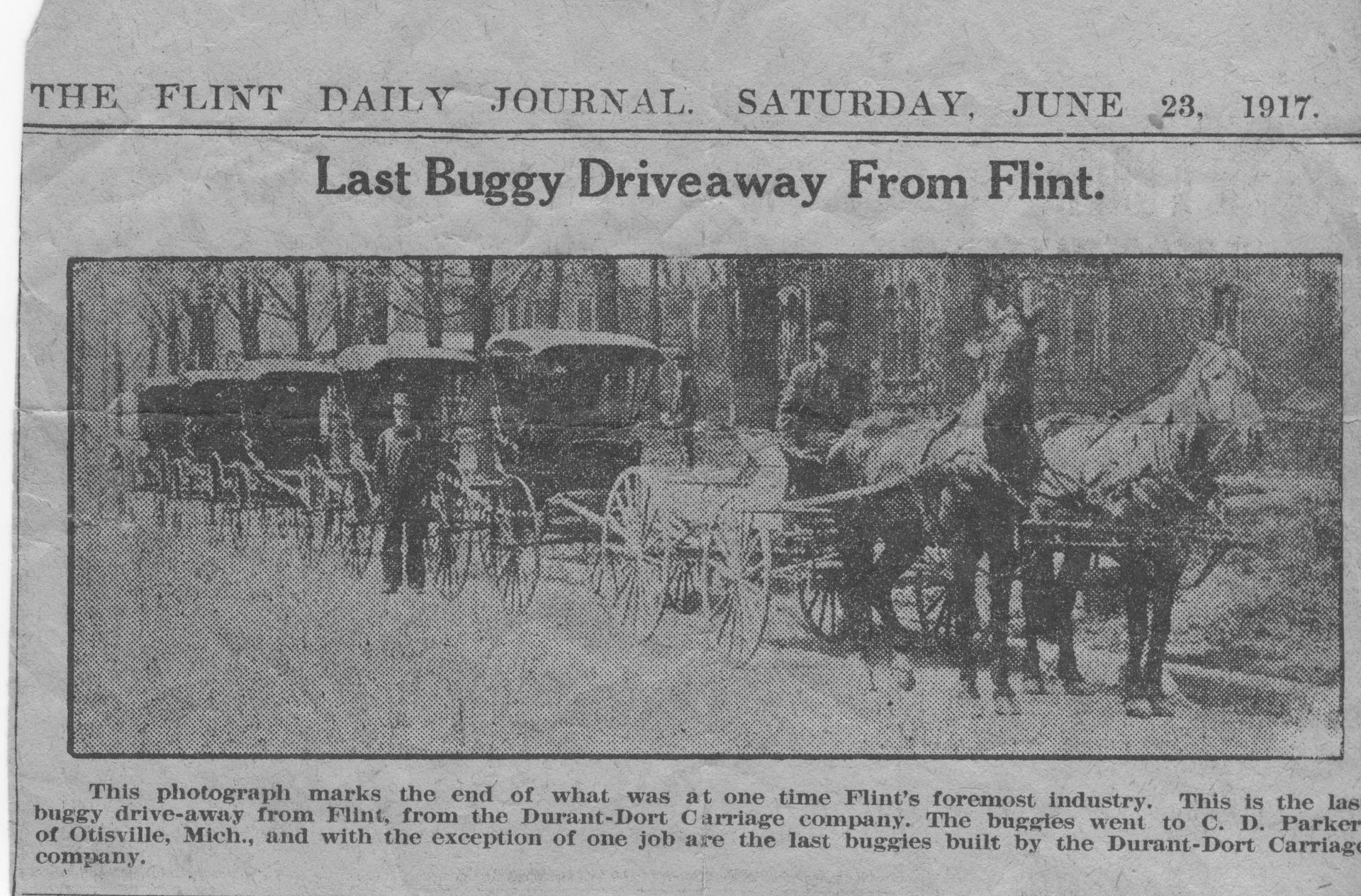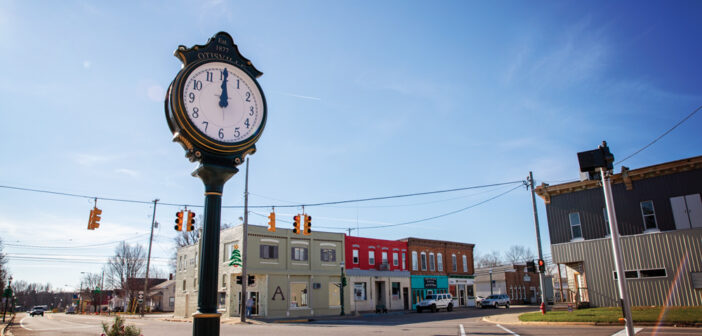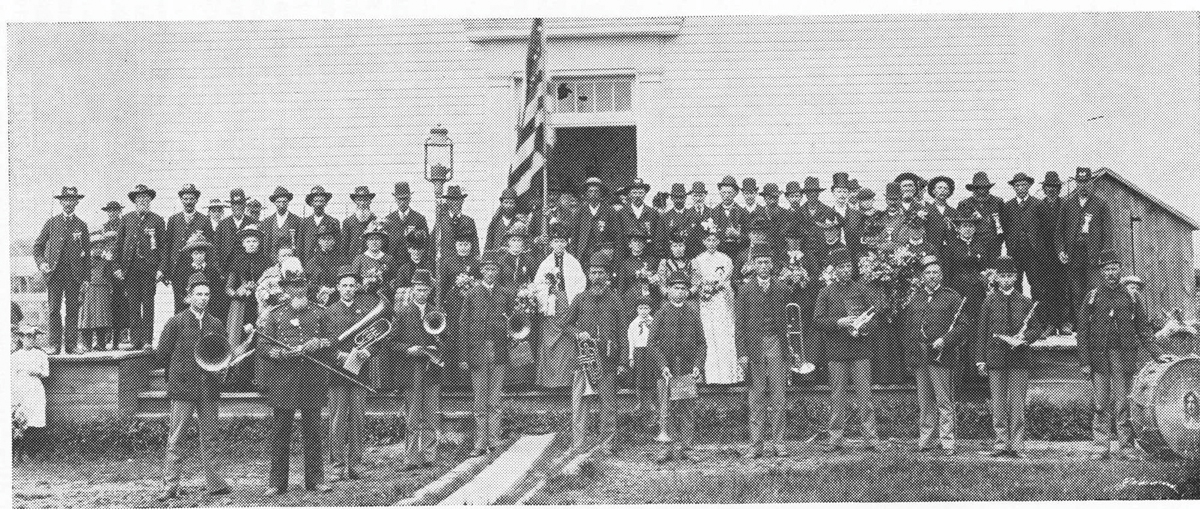Settled: 1836
The people of Forest Township were having a merry time at a party at the home of William R. Smith. The young folks were smiling and dancing, the older pioneers were sipping drinks and talking of politics, hunting and farming. With a revelation of great mirth, the oldest gentleman in attendance, Nathan Smith, proposed a “mock” wedding to further enliven the occasion. Everyone laughed when the homeowner took the hand of Miss Sarah Begel and volunteered the two as tribute. The crowd hushed as Nathan Smith performed the ceremony. “You may kiss the bride!” Mr. Smith announced to much jubilation. William Smith held Miss Begel and kissed her deeply while the crowd cheered with delight. It was then that Nathan Smith told the crowd that they had just witnessed a bona fide marriage! As he was Justice of the Peace, the “mock” ceremony was legally-binding. The new Mr. and Mrs. William R. Smith smiled – it was their plan all along. The roar from the spectators was deafening and the couple received many congratulations. The pioneer and his wife would be together the rest of their lives.
The Early Pioneers
In the early 1830s, as cities grew in the Genesee County’s southern half, the northern extremities belonged to the wilds. The land that would become Thetford Township was nothing more than forest and trails. The Chippewa continued to hunt and fish the land alone until 1835 when Grovener Vinton arrived at his settlement. Shortly after, his daughter, Roxy Ann Vinton, became the first white child born in Thetford. The Vinton family lived alone in town until the summer of 1836 when Isaac and Nelson Van Tuyl arrived. The land then filled quickly. Corydon Fay (first blacksmith), Benoni Clapp, Crawford Barkley, Charles Bottell, William Rice, William Boughton and Rueben Dye took up residence. In 1838, the area received its first post office on the land of Corydon Fay (called Fayville), and the first schoolhouse was also established there. In 1839, Richard Buell arrived and built his home on the banks of the lake that now bears his name. Buell was a great friend to the native Americans who hunted near his land and often engaged in trade with them.
By 1841, the pioneers requested of the state legislature a township all their own. The legislature acquiesced and Thetford was born. Nahum Wilson, a prominent citizen and county man, chose the name as a tribute to the Vermont city of Thetford from which his family originated. Wilson purchased land in Thetford Township in 1838, but didn’t come to stay until five years later. He previously worked in Flint, trading with local natives, and was eventually adopted by the Copneconnick tribe and given the name Winnebidagayis, meaning “the rising sun.” A builder by trade, he helped to build the first bridge over the Flint River and the store of Elisha Beach in Flint.
While Thetford was being settled, one future citizen was traveling the world on the battleship “Ohio” under the direction of Commodore Hull. Franklin Dodge spent his early life reveling in exotic climes. Upon his discharge in 1838, Dodge settled in New York but continued to dream of adventure and decided to strike out as a pioneer. He gathered supplies and visited his neighbor to purchase boots for the journey. Returning with a wife, the Dodge family arrived in Thetford in 1845 and became two of the town’s most prominent citizens.
Around 1846, industry began in Thetford with the Gordon & Cook Mill on Butternut Creek followed by the Buell, Jacob Smith & Bro., Baird, and Rogers mills.The Buell Mill was the first to be powered by steam. At the erection of the Gordon & Cook Mill, a small village formed. Platted by Carlos Wilson, it was named Whitesburg in honor of fellow villager, Clark White. The village (located on the corner of Dodge and Vassar Rds.) was home to a blacksmith (Daniel Morse), wagon shop, a school house and a store/entertainment venue built by Abram Cudney, where he played the fiddle for travelers through all hours of the night.
Another settlement grew around the Buell Mill which had multiple stores, a school house, blacksmith and more. Originally named East Thetford (located at the intersection of Vienna and Belsay Rds.), it was more commonly known amongst travelers as Henpeck due to the ferocity of the female residents.
The area’s most popular hotel was established in 1859 at Thetford Centre by Mrs. Moulthrop and her son, Albert. After Albert perished in the Civil War, she operated Granny’s Tavern in his memory for the rest of her years.
In the mid-1850s, Thetford’s first doctor, Warren Mesick, settled in the township. He practiced for a number of years before giving up his title to Dr. Abram Coddington, and heading to northern Michigan.
Commerce in Thetford Township continued to grow until the Detroit Railroad, through Rogersville in Richfield, put an end to it in 1872.
To the east of Thetford in the land that would be Forest Township, Henry Heister began building his cabin in 1837. Some months later, Heister heard a knock on his door and found Nathaniel Smith and his family looking for shelter on their way north. Heister let them in and there they stayed until a new road was forged. Smith had fled from New York hoping to evade creditors and chose the lands of Forest Township as his hiding place. His grown sons Vandorus, William and Carlton joined him the next summer. The Smith family members never stayed long with the exception of William, who became township treasurer and a most respected man of integrity. He worked always for the people of Forest and turned down all of which he did not earn, including an error of $20 given to him by town officers. “I have twenty dollars here that does not belong to me. It must belong to the town,” he stated, and proceeded to make sure the money went to its rightful entity.
In 1838, Stephen Begel arrived and built the first house in present-day Otisville. Upon arrival, the Begel family immediately lost all of their cattle. The herd was found two weeks later some miles south and the building of the house went faster afterward. When the house was finished, Mr. Begel welcomed his five daughters to town and with them came a wave of young men and dwellings. One of whom, Irish immigrant Matthew McCormick, built the third house in the vicinity of present-day Otisville. His son, John H., was the first white male born in Forest. Future Justice of the Peace, Stephen Seeley, was the next to arrive, leading a parade of settlers that included John Nixon, Harvey Perkins, John Crawford, Jeremiah Olds, William Dimond, John Fry and John Darling.
In 1843, the pioneers petitioned the state legislature to become a township to be named Paris. The legislature agreed, but the name was already taken. One legislator named the township Forest saying, “As it is all woods and nobody lives there, I think we better call it Forest.” The first meeting of the new township took place in the house of Stephen Begel. The first school was built two years later on the land of William Smith, who also taught the students.
As the township slowly filled, commerce slowly grew. In 1851, the first mill was erected by John Hayes near Otisville and was sold a year later to Francis W. Otis. It was the only mill operating until after 1860 when the Seeley, Crawford, Begel, McCrary & Ivory, Hinkle, Wilson, and Hughes mills were built. The trees of the area were so thoroughly logged that by 1879, the only mill still in operation was the first.
In 1855, the state legislature saw fit to lay a state road through the Forest community. The survey was completed by Enos Goodrich and Townsend North. The state road was built through Otisville where a post office was located in 1859 (the name was changed to Otisville in 1861). Three years later, the town’s first physician, Dr. Griswold, traveled up the state road to settle in the area. Prior to his arrival, the townspeople were serviced by doctors traveling from Lapeer County and neighboring townships.

The village of Otisville began with the construction of the Hayes Mill. Workers flocked to the small town that, prior to the mill, consisted of the Begel and McCormick homes. In 1852, George Reed built the first hotel, dubbed American House, to capitalize on the influx of industry. Later, Kellogg & Woodruff established a foundry and in 1859, Ira Sanders built the first store. A year later, William Otis and T. D. Crocker built a new grist mill, which indicated the need for a village. In 1861, Otis and Crocker platted the village and named it Otisville, officially incorporated in 1877. A year before incorporation, Charles P. Russell built the famous Otisville Lodge. In 1878, the first fire department was organized by Charles Moon and the Otisville Observer newspaper was published by Rev. A. G. Blood.
Slightly further north, at the township’s edge, pioneer Andrew McArthur settled on the banks of a wilderness lake – a favorite amongst the local wildlife, especially otters. For that reason, the lake came to be known as Otter Lake. In 1873, a small village sprang up around the lumber industry and the Otter Lake Saw Mill Co. Soon thereafter, the village of Otter Lake was platted and incorporated in 1883.
The Contemporary Era
As the century turned, the townships of Thetford and Forest remained changed mostly by the design and architecture of the times. Forest and field continued unabated, utilized chiefly by farmers and sportsmen.
One of the oldest continually running businesses in Forest Township is the Mumford-Hudson Funeral Home started in 1880 by pioneer John McCormick. In 1901, the business was sold to Paul Laing, then to George Robinson in 1953. In 1964, ownership passed to the Hudson family and in 2011, was purchased by the Mumford family. The business remains one of Genesee County’s oldest funeral homes.
In 1955, the villages of Otter Lake, Columbiaville (Lapeer County) and Otisville combined schools to create Lakeville Community Schools. The name chosen was a combination of “Lake” and “Ville” to represent each municipality. To further education, the Otisville library opened in 1958 on E. Main St. and was enlarged in 1983. The library joined the County system the next year, with the current facility opening to much fanfare in 1996.
Genesee County Parks ventured north to open Buell Lake County Park in Thetford in 1970, to further enhance the pastoral spirit of the town while in Forest, the Covenant Hills Camp opened in 1978 to highlight faith and nature. The land in the townships is beautiful and, in 2016, farmer Lonnie Kester purchased 10.2 miles of the Penn Central Railroad corridor in order to preserve its beauty. He developed the land into the Southern Links Trailway that connects Columbiaville, Otter lake and the city of Millington. Thousands of outdoor enthusiasts enjoy the trailway year-round.
The people of Thetford and Forest Townships are the type of down-to-earth givers who thrive on great hospitality and compassion. The old pioneers were nature enthusiasts and conservationists content with a quiet life of peace and grace, which is reflected in the temperament of today’s citizens.





























